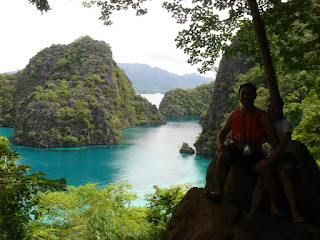Day two of our Coron trip consisted of the Coron Island tour. Coron Island must not be confused with Coron town, which is basically the jump-off point to other island hopping tours (including Coron Island) and is the center of commerce.
Coron Island or Calis as the Tagbanuas call it, is an 86 square meter wedge-shaped island across the bay, around 20 minutes from the town proper via motorized boat. It is home to the indigenous Tagbanuas who act as its primary caretakers. They consider it vital and sacred that although seven lakes are located in the center of the island, only two (Kayangan and Barracuda Lake) are usually open to tourists. The Tagbanuas are very cautious with the island and it is not very difficult to understand why: there has been one too many long-endured battles over their rights for this ancestral domain, part of which serve as a burial ground for their loved ones. Most of them spend their entire lives guarding it, subsisting mainly on fish, which they catch utilizing only hook, line or spear (cyanide fishing and other destructive fishing methods have long been prohibited in Palawan).
Coron Island is also called “The Sleeping Giant”
The island is a smorgasbord of natural wonders – coral gardens, caves, lakes, hidden lagoons, estuaries and secluded pockets of white sand beaches. It is also buffeted by numerous cliffside caves and towering limestone cliffs, all serving as sanctuaries to swiftlets (or balinsasayaw), whose nests, made of bird saliva, are carefully gathered by the Tagbanuas, then sold to Manila and neighboring Asian countries as a main ingredient of the expensive bird’s nest soup.
First in our itinerary was the Siete Pecados Marine Park, a cluster of seven limestone islets at the entrance of Coron Bay, about 15 minutes away from the dock. Myth has it that seven sisters drowned in the ocean looking for their parents, and after their death, seven tiny islands sprouted. Being a marine protected reserve, it is guarded by 2 Tagbanuas, who are also the ones collecting the P100 entrance fee/head (I’d like to call as a maintenance fee, because in reality there’s no land entrances to the area; you simply jump right out in the open seas once you get there). It is regarded as one of the best snorkel sites in the entire Calamianes area.
Siete Pecados is an amazing experience. There’s such a diversity of ocean fish who seem more than happy everytime a boat stops at the area. In what seems to be an automatic reaction to humans, they swarm in groups, waiting for bread crumbs. You could literally see schools of fish swimming at the surface.
There’s plenty of corals and sea urchins at Siete Pecados so always wear your fins!
Fish here are very keen with humans; they’re always in a frenzy for food and wouldn’t be afraid to eat from your fingertips. NOTE: Feeding fish is no longer around at Siete Pecados. Which is a good thing.
Fish on a freeding frenzy
A group of swordfish hunting for food
Next in our Day 2 itinerary was Kayangan Lake, a Hall of Famer awardee for Cleanest Inland Body of Water in the Philippines for many consecutive years. To get to the lake, one must get off the boat then climb 150 steps up and another 150 down a somewhat steep cliff. Do not be disheartened for you will surely be rewarded with a spectacular view at the summit and down by the lake itself.
Approaching the entrance to Kayangan Lake
On a white sandy bar at the lake’s entrance is a guard post where a few Tagbanuas hold lectures on the history, geography and other fun facts about Coron Island. Despite their reserved demeanor, you’d find that the Tagbanuas are courteous and friendly, always smiling and stressing a “Sir” or “Ma’am” everytime they point their pen marker on a certain location on the map (and I tell you, the pointing is quite frequent, it was actually a bit funny). It was so cute seeing an aborigine speaking Tagalog so fluently like a pro.
(Word of advise: Apply a mosquito repellent prior to the trek. Jigs had to learn this the hard way.)
At the edge of the cliff is a small cave that yields a 360 view of the turquoise seas and limestone cliffs fronting Kayangan Lake. It’s one of the most picturesque views of the island.
View of the Kayangan Lake entrance from the cave
Kayangan Lake behind, just a few steps away
Approaching the lake at the other side of the cliff, it wasn’t hard to imagine how Kayangan could have consistently held the title of greenest lake in the country. The turquoise brackish lake, hidden by an array of jagged black limestones is a sight for sore eyes. Tourists swarmed the area one after another, lavishing on its still halocline waters, yet there was sweet, silent equilibrium hovering it. Swimming in the lake is relaxing to say modestly.
One can easily spot groups of miniscule freshwater fish and underwater stalagmite rocks merely sitting on the platform by the lakeside, proof of how crystal clear the water is.
Beneath the water are sharp-edged stalagmite formations
We were supposed to drop by Barracuda Lake – the riskier, more adventurous counterpart of Kayangan – but Ryan told us that the Tagbanuas had limited visiting the lake to certified divers only as there have been many instances when guests played rowdy bodyjumping games in the water despite warnings of a noise-allergic resident barracuda (as a result, the barracuda swam its way up and had a treacherous brush with these guests – although there were no reported casualties). Thus, only picture taking at the lake’s entrance is allowed these days (sigh). So we just headed out for Banol Beach to have our picnic lunch and swim a bit.
Approaching Banol Beach
Banol is the most popular of numerous beach pockets in Coron Island. A short distance away from Kayangan Lake, it is a popular spot for picnic lunches. It boasts crystal clear waters and sugary white sand set below a canopy of trees and limestone rocks. Three cozy huts come with the P100 entrance fee.
We had a most satisfying lunch comprised of grilled fish and liempo, buttered crabs, tortang talong and fresh fruit, eating with our bare hands 🙂
Underneath the water is a bed of seagrass, few corals and sea urchins.
There are other beaches located on either side of Banol where visitors can opt for in case Banol is already full (although I have to say, Banol still has the most promising beach among them all). All of them have a standard rate of P100/head for the entrance.
1) Beach 69/ Maynuno / Sunset Beach – free entrance if you’re coming from Kayangan Lake. It is said that it’s called Beach 69 after a group of students who carved the phrase “Batch 69” in one of the rocks.
2) Atuayan – the place was originally called Katuayan from the word Tuay, meaning shell, which is abundant in the area. It is situated next to Barracuda Lake and has the longest beachfront in all Coron Island beaches. Having calm waters and a decent snorkeling area, it is a nice choice for families with small kids.
3) Smith’s Point – located beside Banol, at the right side of the cove. It is a small, private beach where only two boats can dock at a time.
4) Caliwantay/ Beach 91 – located at the left side, between Banol and Atuayan. Check out our Coron Day 3 Adventure for pictures of Beach 91 and other details.
Our last stop for the day was the Twin Lagoon, which as its name suggests, are a pair of lagoons separated by a huge limestone. There is a small passage underneath that limestone that’s visible during lowtide and where one can swim through to the other lagoon (or by riding a raft). Otherwise, you may have to opt for the improvised stairs to get to the other side.
The outer lagoon serves as a docking area for boats
A rock with a small passage divides the two lagoons and yields thrill for the adventurous
Approaching the entrance, you could get a peak of a somewhat visible black rock adorned with short bushes and trees. But I wasn’t really prepared for the spectacle of awe awaiting at the end of that hole. The first thing that came out of my mouth was “Wow.” Besides that, well, I was simply dumbfounded.
Imagine being surrounded in a circle of colossal limestones a hundred feet high, with tree branches hanging out of the edges, birds flying out of secret corners. It was like that feeling you get as a child, seeing airplanes in the sky for the first time. Hell, maybe that’s even an underrated description. The sight was just awesome and pictures are not enough to describe how beautiful the place is. I swam on my back for long and there was nothing but a feeling of serenity being walled in such a wonder.
Like Kayangan Lake, Twin Lagoon‘s water is brackish; if observed closely, there is an eerie illusion of oil mixed in water. Ryan said that this is because the water is a mixture of saltwater and freshwater. The surface is freshwater (thus, cold), but as one descends deeper , it becomes warmer because of saltwater.
There are visible corals, shells and few fish underneath and a deep cavernous center with almost zero visibility. This is the part where divers supposedly begin their night dives.
Approaching the port
Later in the evening, we scoured the town for dinner. We found a couple of famous diners in the area. One of which is Bistro Coron, a French-owned restobar famous for its pizza and pasta recipes. We found the place quite awkward and a bit biased, with mostly foreign nationals filling the tables and waitresses antsy to cater to their needs before the locals’.
On the other side of the street is Trining Bacsa, a well-known carinderia that serves mainly Filipino dishes at very affordable prices.
I liked to try their famous caldereta but Jigs was craving for something greasy and deep fried. In the end, we just decided to go back to Darayonan and tried their fried chicken and another viand which is just as forgettable. Food was quite below par, too little in serving and way overpriced at that rate. The one redeeming factor in Darayonan’s restaurant – aside from the longganisa which we had for breakfast earlier in the day – was probably the local ornamental display.



















































interesting blog
Had a good time in Coron too. Will definitely coming back there, I miss the beaches, island, amazing view, clear water, swimming fishes, sunset..
Truly, Coron is one awesome island to be missed! Hope to make a return there, too, someday. By the way, where did you get those Coron shakes? Looks tempting 🙂